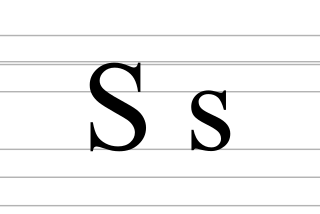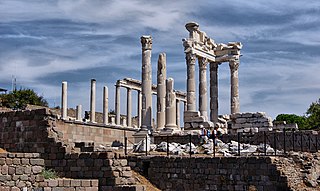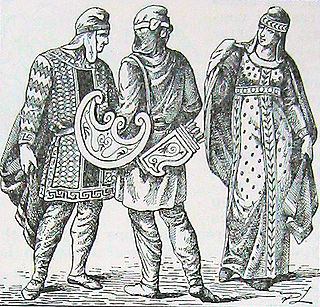
Greek is an Indo-European language, constituting an independent Hellenic branch within the Indo-European language family. It is native to Greece, Cyprus, Italy, southern Albania, and other regions of the Balkans, Caucasus, the Black Sea coast, Asia Minor, and the Eastern Mediterranean. It has the longest documented history of any Indo-European language, spanning at least 3,400 years of written records. Its writing system is the Greek alphabet, which has been used for approximately 2,800 years; previously, Greek was recorded in writing systems such as Linear B and the Cypriot syllabary. The alphabet arose from the Phoenician script and was in turn the basis of the Latin, Cyrillic, Coptic, Gothic, and many other writing systems.

S or s, is the nineteenth letter of the Latin alphabet, used in the English alphabet, the alphabets of other western European languages and other latin alphabets worldwide. Its name in English is ess, plural esses.

Mysia was a region in the northwest of ancient Asia Minor. It was located on the south coast of the Sea of Marmara. It was bounded by Bithynia on the east, Phrygia on the southeast, Lydia on the south, Aeolis on the southwest, Troad on the west, and the Propontis on the north. In ancient times it was inhabited by the Mysians, Phrygians, Aeolian Greeks and other groups.

Umbrian is an extinct Italic language formerly spoken by the Umbri in the ancient Italian region of Umbria. Within the Italic languages it is closely related to the Oscan group and is therefore associated with it in the group of Osco-Umbrian languages, a term generally replaced by Sabellic in modern scholarship. Since that classification was first formulated, a number of other languages in ancient Italy were discovered to be more closely related to Umbrian. Therefore, a group, the Umbrian languages, was devised to contain them.
Sampi is an archaic letter of the Greek alphabet. It was used as an addition to the classical 24-letter alphabet in some eastern Ionic dialects of ancient Greek in the 6th and 5th centuries BC, to denote some type of a sibilant sound, probably or, and was abandoned when the sound disappeared from Greek.
Lydian is an extinct Indo-European Anatolian language spoken in the region of Lydia, in western Anatolia. The language is attested in graffiti and in coin legends from the late 8th century or the early 7th century to the 3rd century BCE, but well-preserved inscriptions of significant length are so far limited to the 5th century and the 4th century BCE, during the period of Persian domination. Thus, Lydian texts are effectively contemporaneous with those in Lycian.

Luwian, sometimes known as Luvian or Luish, is an ancient language, or group of languages, within the Anatolian branch of the Indo-European language family. The ethnonym Luwian comes from Luwiya – the name of the region in which the Luwians lived. Luwiya is attested, for example, in the Hittite laws.

Mysians were the inhabitants of Mysia, a region in northwestern Asia Minor.
Dacian is an extinct language generally believed to be a member of the Indo-European language family that was spoken in the ancient region of Dacia.

Old Latin, also known as Early, Archaic or Priscan Latin, was the Latin language in the period roughly before 75 BC, i.e. before the age of Classical Latin. A member of the Italic languages, it descends from a common Proto-Italic language; Latino-Faliscan is likely a separate branch from Osco-Umbrian. All these languages may be relatively closely related to Venetic and possibly further to Celtic; see the Italo-Celtic hypothesis.
The Thracian language is an extinct and poorly attested language, spoken in ancient times in Southeast Europe by the Thracians. The linguistic affinities of the Thracian language are poorly understood, but it is generally agreed that it was an Indo-European language.
The Phrygian language was the Indo-European language of the Phrygians, spoken in Anatolia, during classical antiquity.

The Phrygians were an ancient Indo-European speaking people who inhabited central-western Anatolia in antiquity.

Various alphabetic writing systems were in use in Iron Age Anatolia to record Anatolian languages and Phrygian. Several of these languages had previously been written with logographic and syllabic scripts.
The Phrygian alphabet is the script used in the earliest Phrygian texts.

The linguistic classification of the ancient Thracian language has long been a matter of contention and uncertainty, and there are widely varying hypotheses regarding its position among other Paleo-Balkan languages. It is not contested, however, that the Thracian languages were Indo-European languages which had acquired satem characteristics by the time they are attested.

In classical antiquity, Phrygia was a kingdom in the west-central part of Anatolia, in what is now Asian Turkey, centered on the Sangarios River.
Graeco-Phrygian is a proposed subgroup of the Indo-European language family which comprises the Hellenic and Phrygian languages.
![]() sign represented a sibilant, transcribed as š or z, but since 1969 it is known that it actually denoted a /j/ sound, transcribed as y. The
sign represented a sibilant, transcribed as š or z, but since 1969 it is known that it actually denoted a /j/ sound, transcribed as y. The ![]() sign was thought to be a sound not present in the regular Old-Phrygian alphabet and dubbed the "Mysian s", transcribed as ś, but it was in fact the regular s. The
sign was thought to be a sound not present in the regular Old-Phrygian alphabet and dubbed the "Mysian s", transcribed as ś, but it was in fact the regular s. The ![]() sign was formerly transcribed s, but it is in fact the equivalent of the Phrygian
sign was formerly transcribed s, but it is in fact the equivalent of the Phrygian ![]() sign, probably denoting a /z/, /zd/, or /ts/ sound. [7]
sign, probably denoting a /z/, /zd/, or /ts/ sound. [7] 









